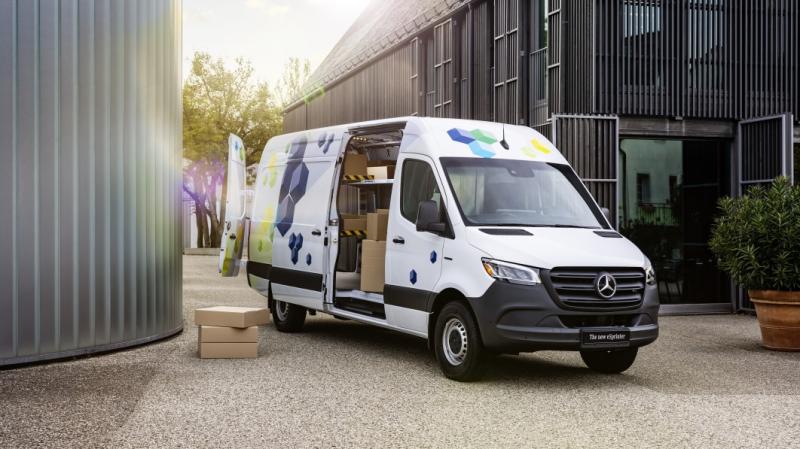2024 Mercedes-Benz eSprinter electric van will be built and sold in U.S.
By: Ronan Glon (Autoblog)


The 2024 Mercedes-Benz eSprinter gets more driving range thanks to new technology, and it will be sold in the United States starting in late 2023.

Delivery vans are a large, and largely negative, part of America's urban landscape. They are not great...
With relatively modest, known distances, delivery vans are ideal for electrification. Zevo and Rivian are pumping out a bunch...


If you're thinking "the new eSprinter looks just like the old one," you're right on. Mercedes hasn't made any significant changes to the van's design, and it hasn't done much to differentiate the electric model from its diesel-burning counterpart. I learned that this was intentional.
"We said, 'Let's keep the outside design as-is and put the new technology in the underbody, that way everyone still knows this is a Sprinter,'" Benjamin Kaehler, the chief engineer of Mercedes-Benz's electric vans division, told me. There are other reasons for not making major changes: The Sprinter needs to be a lot of things to a lot of people, and keeping the body, body panels, and trim pieces unchanged ensures repair costs stay low for fleet operators and makes the van easier to modify for the numerous companies already working with diesel models.
The noteworthy changes are under the body. Mercedes-Benz divided the powertrain into three basic modules: the front section includes the high-voltage components, the middle section is essentially the battery pack that's mounted under the floor, and the rear section consists of the electric motor, the axles, and all related hardware. This approach makes the eSprinter modular: it's kind of like a Lego kit. The company can install different battery pack without having to design different underbodies for each, which in turns brings down production costs.
In the United States, the eSprinter will only be offered with the largest battery pack in the lineup. It's a 113-kilowatt-hour lithium-iron-phosphate unit that zaps a rear-mounted motor into motion. Driving range checks in at up to 248 miles, according to the testing cycle used in Europe, and the firm pegs the van's range in city traffic at up to 311 miles. It demonstrated what the new eSprinter is capable of by driving a prototype for 295 miles on a single charge in November 2022, though I learned that the the van was carrying merely 88 pounds in the back.
The motor is available in two states of tune rated at 134 and 201 horsepower, respectively, and both variants develop 295 pound-feet of torque. The drivetrain is compatible with 115-kilowatt fast-charging, and going from 10% to 80% takes about 42 minutes. Buyers in Europe will have access to two smaller battery packs with a capacity of 56 and 81 kilowatt-hours, respectively, but these will not be offered in the United States, largely because driving range drops to a level that Mercedes-Benz doesn't think is acceptable for our market.

Image Credit: Ronan Glon
Putting the battery pack under the floor gives the eSprinter the same cavernous loading space as a comparable diesel-powered model; buyers will have 488 cubic feet to fill with their stuff or parcels. However, the limitations of electric technology give the battery-powered van payload and towing capacities of about 2,624 and 3,300 pounds, respectively, which fall well short of what the standard Sprinter is capable of (up to 7,429 and 7,500 pounds, respectively, in its most capable configuration). Similarly, the eSprinter wasn't designed as a people-hauler.
"We are a little bit limited regarding the payload, especially when we're talking about a van equipped with the bigger battery. For sure, [the payload] is reduced, and then it's quite a difficult use case. You have two options: reduce the battery capacity and limit range to get more seats inside, or go with less seats and more range, which is also not perfectly suitable," Markus Reis, the eSprinter's product manager, told me. The same goes for RVs. "[Most RV customers] want more range, which at the moment isn't easy to achieve," he added. He also noted that the new eSprinter is primarily aimed at companies with a fleet of delivery vans and those in the service and craft sectors.
Mercedes-Benz dealers in the United States and Canada will begin receiving the eSprinter in the second half of 2023. The only configuration offered here will be a long-wheelbase van with a high-roof; other markets will receive other configurations, including a chassis-cab. Pricing information hasn't been announced yet, but Mercedes notes that American-market vans will be built in Charleston, South Carolina.
At launch, the list of standard features will include 50-kilowatt charging capability, a heated driver's seat, a multi-function steering wheel, remote EV services (like cabin pre-conditioning), and wiring for a trailer hitch. Options include 115-kilowatt fast-charging capability, a 10.25-inch touchscreen for the MBUX infotainment system, a digital rear-view mirror, power-adjustable front seats, and a heated steering wheel.
What's next?
Mercedes-Benz is developing a modular electric platform called Van.EA that it will use to underpin electric commercial vehicles starting in 2025. The architecture is being developed exclusively with electric technology in mind, and it's not compatible with internal-combustion engines. Time will tell how switching to an electric-only platform affects the Sprinter in terms of design, practicality, and driving range.
Hydrogen isn't on the company's radar — at least not yet.
"We have some concept cars [powered by hydrogen]. As of now, we think that the big, 113-kilowatt-hour battery pack should be sufficient for, let's say, 95% of the customers. With the upcoming new cars based on this Van.EA platform the range will even get higher, so as of now we don't see the need for hydrogen. But, never say never," Kaehler told me.

Tags
Who is online
37 visitors


This is the kind of "important news" that is largely unknown to the general public.
They will find out next year when the Sprinter returns to America.
It has more room inside and higher clearance than its 2 competitors
and excellent resale value.
Any idea what the base sale price is for this vehicle?
I wonder if it will qualify for the e-vehicle tax credits and if that had anything to do with building it here.
Good questions... and I have no idea!
Yes, as of changes made, Vehicles bought after August 16, 2022;
to qualify the final assembly must be in North America .
Thanks to the Inflation reduction act. I'd love to get one to replace my old Chevy plumbing van. It has about 230k miles on it now but I'm probably just going to retire so it wouldn't be that good an investment right now.
The Sprinter is very popular as a class B motorcoach. If they add the EV to the existing Sprinter that is used as a class B they may have a really big winner on their hands.
The range may be a problem.
Perfect for delivery vehicles in the Dallas area, esp Amazon,
which watches the news every day expecting Rivian to not be capable of delivering the next
99,000 vehicles Amazon ordered...
Yippee ki yay ..... up go your shipping costs.
No problem though. just add it to the growing list of higher cost items today.